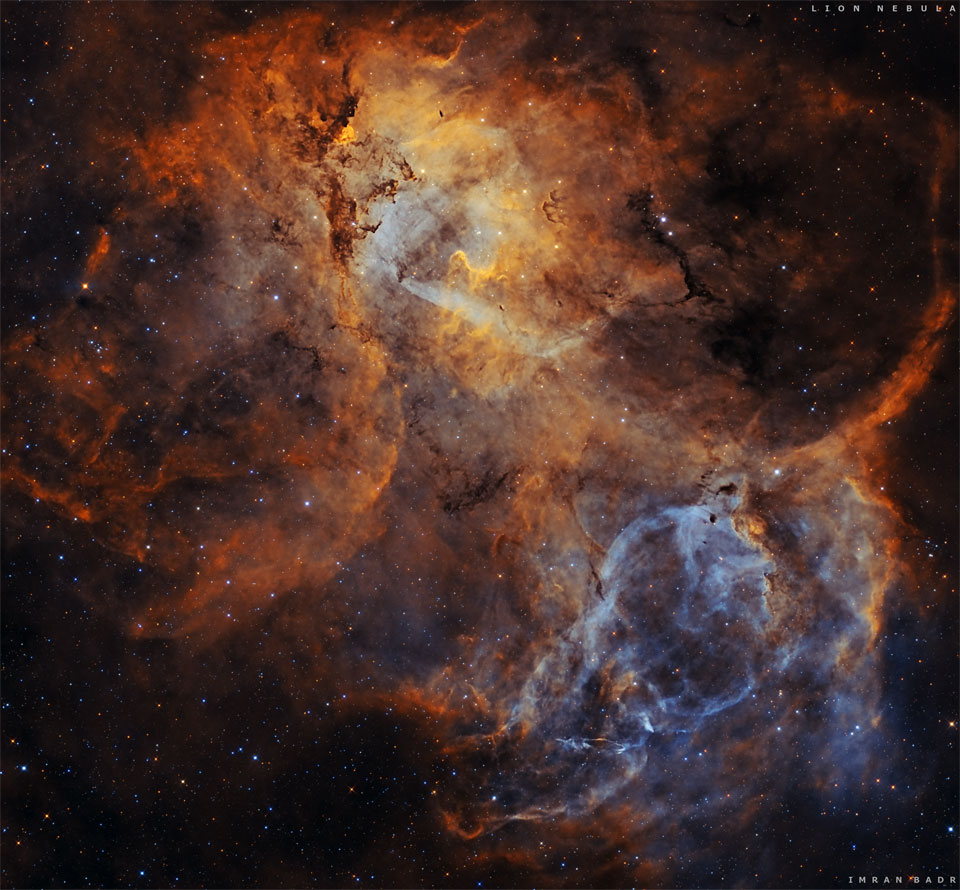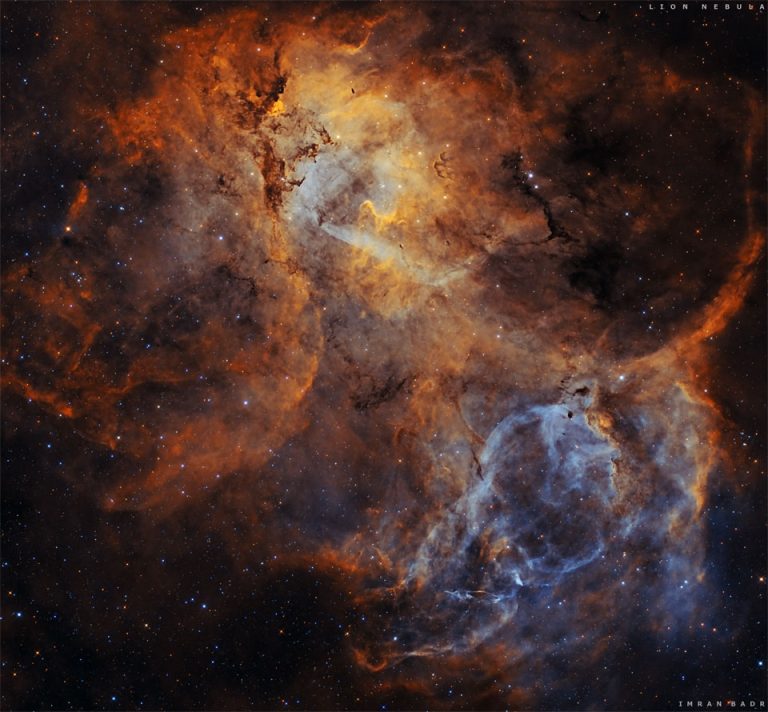Space Photo by NASA Today: 2024 June 10
Key Takeaway
The Lion Nebula (Sh2-132) is a majestic and powerful nebula located in the constellation Cepheus. Powered by two massive stars, this nebula is a stellar nursery where new stars are born from shells of ionized gas. Its angular size is slightly greater than that of the full moon, and it resides about 10,000 light years away.
Space Photo by NASA Today: 2024 June 10
Summary
- Lion Nebula Overview
- Named Sh2-132, located in the constellation Cepheus.
- Powered by two stars with over 20 times the mass of the Sun.
- Angular size greater than the full moon.
- 10,000 light years away.
- Characteristics and Formation
- Formed from shells of ionized gas.
- Glows due to energetic matter.
- Dense enough to form new stars.
- Astronomical Significance
- Important site for star formation.
- Provides insight into the life cycles of stars.
- Highlights the dynamic nature of nebulae.
- Observation Techniques
- Use of telescopes for detailed images.
- Spectroscopy for analyzing composition.
- Space missions for enhanced clarity.
- Historical and Cultural Context
- Named after the King of Aethopia in Greek mythology.
- Reflects the rich history of celestial naming conventions.
- Famous Nebulae for Comparison

Image Credit & Copyright: Imran Badr; Text: Natalia Lewandowska (SUNY Oswego)
Introduction
The universe is filled with fascinating and beautiful objects, and nebulae are among the most spectacular. These vast clouds of gas and dust serve as the birthplaces of stars, offering a glimpse into the dynamic processes that shape the cosmos. Today, we explore the Lion Nebula, also known as Sh2-132, located in the constellation Cepheus.
Lion Nebula Overview
The Lion Nebula, officially named Sh2-132, is a stunning region of ionized gas located in the constellation Cepheus. This nebula is powered by two massive stars, each with a mass over 20 times greater than our Sun. These stars energize the surrounding gas, causing it to glow brightly. The Lion Nebula’s angular size is slightly greater than that of the full moon, making it a prominent feature in the night sky for those with the right equipment to observe it.
The Lion Nebula is approximately 10,000 light years away from Earth. This vast distance means that the light we see from the nebula today actually left it 10,000 years ago. The nebula’s location in the constellation Cepheus, named after the King of Aethopia in Greek mythology, adds to its mystique and cultural significance.
Characteristics and Formation
The Lion Nebula is formed from shells of ionized gas that have expanded over time. These shells are the result of powerful stellar winds and radiation from the massive stars at the nebula’s core. As these energetic particles collide with the surrounding gas, they cause it to ionize and emit light, creating the beautiful glow that we see.
The matter within the Lion Nebula is not only energetic but also dense enough to contract gravitationally. This process can lead to the formation of new stars, making the Lion Nebula a stellar nursery. The cycle of star formation and destruction within nebulae like Sh2-132 is a crucial aspect of the cosmic lifecycle.
Table 1: Characteristics of the Lion Nebula (Sh2-132)
| Characteristic | Description |
|---|---|
| Name | Lion Nebula (Sh2-132) |
| Location | Constellation Cepheus |
| Distance from Earth | 10,000 light years |
| Angular Size | Slightly greater than the full moon |
| Central Stars | Two massive stars, >20 times the mass of the Sun |
| Formation Process | Shells of ionized gas expanding and contracting |
Astronomical Significance
The Lion Nebula is a significant site for the study of star formation and the life cycles of stars. By observing regions like Sh2-132, astronomers can gain valuable insights into the processes that lead to the birth of stars and the distribution of elements in the galaxy.
Birthplaces of Stars
Nebulae like Sh2-132 are often referred to as stellar nurseries because they are regions where new stars are born. The dense regions of gas within the nebula can collapse under their own gravity, forming protostars. These protostars continue to accumulate mass from the surrounding gas and dust until they ignite nuclear fusion, becoming fully-fledged stars.
Sources of Heavy Elements
The massive stars within the Lion Nebula play a crucial role in the synthesis of heavy elements. Through the process of nuclear fusion, these stars convert hydrogen into heavier elements like helium, carbon, and oxygen. When these stars eventually die, they eject these elements into space, enriching the interstellar medium and providing the raw materials for future generations of stars and planets.
Galactic Recycling
The dynamic nature of nebulae like Sh2-132 highlights the concept of galactic recycling. The material ejected from dying stars is incorporated into new stars and planetary systems, driving the ongoing evolution of galaxies. This process ensures that the elements necessary for life are continuously replenished throughout the cosmos.
Observation Techniques
Telescopes
Telescopes are essential tools for observing nebulae. Ground-based telescopes, such as those at the Mauna Kea Observatories in Hawaii, provide detailed views of nebulae in visible light. Space telescopes, such as the Hubble Space Telescope, offer unparalleled clarity by avoiding the distortion caused by Earth’s atmosphere.
Spectroscopy
Spectroscopy involves analyzing the light from nebulae to determine their composition, temperature, density, and motion. By studying the spectra of nebulae, astronomers can learn about the physical conditions and processes occurring within them. This technique is particularly useful for identifying the presence of specific elements and molecules in the nebula.
Space Missions
Space missions have significantly enhanced our understanding of nebulae. The Hubble Space Telescope, launched in 1990, has captured stunning images of nebulae, revealing intricate details and structures. Upcoming missions, like the James Webb Space Telescope, promise to provide even deeper insights into these fascinating objects. These missions allow astronomers to observe nebulae in different wavelengths of light, including infrared and ultraviolet, which are not accessible from the ground.
Table 2: Observation Techniques for Nebulae
| Technique | Description | Example |
|---|---|---|
| Telescopes | Instruments that collect and magnify light from celestial objects | Hubble Space Telescope |
| Spectroscopy | Analysis of light to determine composition and physical properties | Identifying elemental composition |
| Space Missions | Missions that deploy telescopes and instruments in space | James Webb Space Telescope |
Historical and Cultural Context
The Lion Nebula’s location in the constellation Cepheus adds a rich layer of historical and cultural context to its scientific significance. Cepheus is named after the mythical King of Aethopia, a character from Greek mythology. This connection reflects the long-standing human tradition of naming celestial objects after mythological figures and stories.
In mythology, Cepheus was the husband of Cassiopeia and the father of Andromeda. The constellation bearing his name has been recognized since ancient times, highlighting the enduring human fascination with the night sky and the stories it holds.
Famous Nebulae for Comparison
The Lion Nebula is just one of many remarkable nebulae in the universe. Comparing it to other famous nebulae helps to appreciate its unique features and significance.
Orion Nebula
The Orion Nebula (M42) is one of the most famous and easily visible nebulae in the night sky. Located in the constellation Orion, it is a stellar nursery where new stars are being born. The nebula is about 1,344 light years away and spans about 24 light years. Its vibrant colors and intricate structures make it a popular target for amateur and professional astronomers alike.
Eagle Nebula
The Eagle Nebula (M16) is home to the famous “Pillars of Creation,” towering columns of gas and dust where new stars are forming. Located in the constellation Serpens, it is about 7,000 light years away. The Hubble Space Telescope’s images of the Eagle Nebula have become iconic, showcasing the dramatic and awe-inspiring nature of star formation.
Crab Nebula
The Crab Nebula (M1) is the remnant of a supernova explosion observed in 1054 AD. Located in the constellation Taurus, it is about 6,500 light years away. The nebula is expanding at a rate of about 1,500 kilometers per second, providing a dynamic laboratory for studying the aftermath of stellar explosions.
Conclusion
The Lion Nebula (Sh2-132) is a powerful and majestic nebula located in the constellation Cepheus. Powered by two massive stars, it serves as a stellar nursery where new stars are born. Its formation from shells of ionized gas and its role in the galactic recycling process highlight the dynamic and ever-changing nature of the cosmos.

